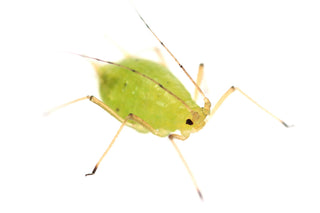What is an aphid?
Aphids are very small, soft-bodied, and pear-shaped sucking insects. They are seen in a variety of colours such as green, black, brown, yellow, and red. They develop wings when they mature. These aphids have two pipes at the end of their abdomen. The mode of feeding is through sucking the sap of plants and releasing sweet honeydew which attracts insects along with the fungus.

Why are aphid pests?
Aphids may damage the plants and also invites other parasites to cause infections and damage to the plants, this is the reason they are considered a pest for many crops. Aphid causes leaf curling, discoloration, yellowing, and stunted development in a wide range of crops by sucking the xylem or sap fluids from the plants. This fluid is a sticky, sweet waste product called honeydew which initiates large infestations.
Aphid damages the many plants in the following ways:
- Leaf-feeding aphids in small to moderate numbers aren't frequently a problem in gardens or on trees. On other hand, enormous populations can turn plant growth shunted and yellowing in leaves; aphids can also create large amounts of honeydew, a sticky fluid that sometimes becomes black when a mold or fungus grows on it.
- A poison is injected by some aphid species into the xylem and leaves of plants, causing leaves to curl, deform, and further distort growth. Gall development is caused by a few species of these aphids.
- On ornamental and vegetable plants, aphids can spread viruses from one plant to another. Squash, pumpkin, beet, cucumber, melon, potato, chard, bean, bok choy, and lettuce are crops that are frequently infected by aphids. Plant development is stunted by viruses that cause leaves to mottle, yellow, or even curl. The management of aphids is difficult since infection can spread when aphid levels are low; these aphids need a few minutes to spread the virus among the crop, whereas killing aphids with pesticides/insecticides may take considerably longer.
- Few aphids attack parts of plants other than stems and leaves. In the growing season of lettuce, aphids strike at the lettuce roots and damage them. This damage results in wilting and dying of plants.
- In fall, some species of aphid attack the poplar tree. They lay eggs on the tree; these eggs hatch after the winter and in the spring cause leaf gall.
- Similarly, woolly apple aphids attack and cause infection in woody sections of apple limbs and roots, particularly around pruning areas. If roots are continuously affected for multiple years, it results in overall tree deterioration.
- Aphids also rush on the roots and crown of carrots and weakened them by heavy infestations, this weakens the root/carrot which breaks off when carrots are pulled at harvesting.
Management:
When there are numerous attacks of aphids, apply a chemical pesticide to the crops. The resilience of green melon and peach aphids to numerous pesticides is one of the issues with controlling them. In particular areas and among aphid species, they have developed resistance against organophosphate pesticides. So use alternative pesticides or advanced pesticides for aphids available in your gardening store.
The best way to keep aphids at bay within the common garden are with beneficial insects such as Hoverflies, lacewings, ladybirds and parasitic wasps are some of the most abundant and powerful natural enemies of aphids. Ladybirds can eat up to 100 aphids a day! Provided they have not been harmed by toxic pesticides.

You can purchase all of these beneficial insects in abundance at Bugs for Bugs.




